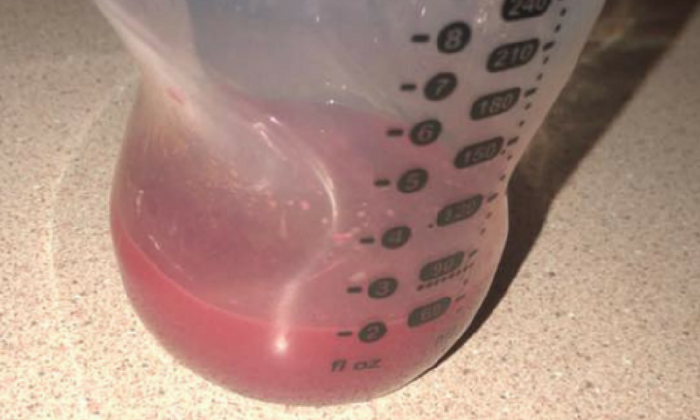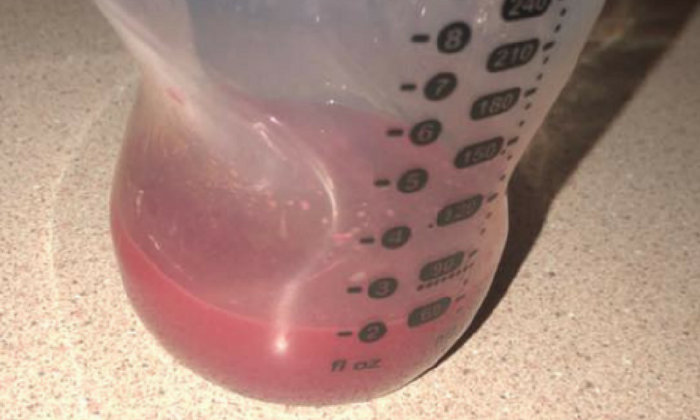According to the Centers for Disease Control, a baby’s saliva transfers chemicals to his or her mom’s body and she reacts by producing breast milk according to those needs. This is why breast milk can take on that rich yellow tone when a little one is sick. But this natural phenomenon isn’t the reason a mom’s breast milk came out fuchsia. The woman from Australia, who wishes to remain anonymous, explained in a closed breastfeeding group that she first realized something odd was going on when her 16-month-old started acting unusually when she tried to nurse. The toddler started pulling at her nipple and saying “No more!” instead of happily drinking mama’s milk. The stimulation caused some milk to squirt out, and this mom was understandably alarmed when she saw its vibrant tone. The concerned mom began expressing more milk to see if it continued coming out pink, and to her surprise, the color stayed consistent. Breastfeeders in Australia/Facebook More from CafeMom: Side-by-Side Photos of Breast Milk Pumped 3 Days Apart Prove Its Healing Magic She then had a sudden realization: She’d eaten a bunch of beets that day. “Safe to say I nearly had a heart attack until I realized,” she wrote in the Breastfeeders in Australia group. According to the mom, during the course of that day she drank a juice that contained some fresh beets, ate a sandwich that was topped with the vegetable, and capped the day off with a can of them. However, she never expected that what she ate when it came to vegetables could have that drastic of an impact on her breast milk. After explaining to online users that she was confident that the hue wasn’t from blood (her little one’s urine was also pink from the tinted breast milk), she decided to take them up on their urges to taste it for herself. More from CafeMom: Breastfeeding Mom Shamed for Pumping in a Bathroom Because Nowhere Is Safe Mom admitted that she isn’t familiar with how her breast milk normally tastes, but she did say that the beet batch is extremely sweet. This left some online wondering if colored breast milk is safe for a baby to drink — but it’s, in fact, “completely harmless,” per La Leche League International (LLLI). According to LLLI, a woman’s diet can change her breast milk from white to blue, green, pink, yellow, or even black. Yams, squash, pumpkins, and carrots are common color-changing culprits, but even if the cause was blood from cracked nipples, it’s still safe for baby. “The color of human milk can vary,” the LLLI website states. “Colostrum is generally yellow to yellow-orange. The transition from colostrum to mature milk can take about two weeks to complete. During that time, the color changes gradually to a bluish white color. However, the color of mature milk may change because of mother’s diet or medications. Food dyes used in carbonated sodas, fruit drinks, and gelatin desserts have been associated with milk that is pink or pinkish orange. Greenish milk has been linked to consuming green-colored sports beverages, seaweed, or large amounts of green vegetables. One woman consuming a certain prescription medication reported black milk. Frozen milk may look yellowish.” The Australian Breastfeeding Association explained that this range of colors can catch moms off guard, as most of the time moms aren’t aware of their milk’s color while they’re breastfeeding. So if you express some green milk after binging on spinach or salads, don’t be immediately freaked out!



title: “Mom Seriously Confused After Her Breast Milk Turns Bright Pink” ShowToc: true date: “2024-09-22” author: “Jennifer Connolly”
According to the Centers for Disease Control, a baby’s saliva transfers chemicals to his or her mom’s body and she reacts by producing breast milk according to those needs. This is why breast milk can take on that rich yellow tone when a little one is sick. But this natural phenomenon isn’t the reason a mom’s breast milk came out fuchsia. The woman from Australia, who wishes to remain anonymous, explained in a closed breastfeeding group that she first realized something odd was going on when her 16-month-old started acting unusually when she tried to nurse. The toddler started pulling at her nipple and saying “No more!” instead of happily drinking mama’s milk. The stimulation caused some milk to squirt out, and this mom was understandably alarmed when she saw its vibrant tone. The concerned mom began expressing more milk to see if it continued coming out pink, and to her surprise, the color stayed consistent. Breastfeeders in Australia/Facebook More from CafeMom: Side-by-Side Photos of Breast Milk Pumped 3 Days Apart Prove Its Healing Magic She then had a sudden realization: She’d eaten a bunch of beets that day. “Safe to say I nearly had a heart attack until I realized,” she wrote in the Breastfeeders in Australia group. According to the mom, during the course of that day she drank a juice that contained some fresh beets, ate a sandwich that was topped with the vegetable, and capped the day off with a can of them. However, she never expected that what she ate when it came to vegetables could have that drastic of an impact on her breast milk. After explaining to online users that she was confident that the hue wasn’t from blood (her little one’s urine was also pink from the tinted breast milk), she decided to take them up on their urges to taste it for herself. More from CafeMom: Breastfeeding Mom Shamed for Pumping in a Bathroom Because Nowhere Is Safe Mom admitted that she isn’t familiar with how her breast milk normally tastes, but she did say that the beet batch is extremely sweet. This left some online wondering if colored breast milk is safe for a baby to drink — but it’s, in fact, “completely harmless,” per La Leche League International (LLLI). According to LLLI, a woman’s diet can change her breast milk from white to blue, green, pink, yellow, or even black. Yams, squash, pumpkins, and carrots are common color-changing culprits, but even if the cause was blood from cracked nipples, it’s still safe for baby. “The color of human milk can vary,” the LLLI website states. “Colostrum is generally yellow to yellow-orange. The transition from colostrum to mature milk can take about two weeks to complete. During that time, the color changes gradually to a bluish white color. However, the color of mature milk may change because of mother’s diet or medications. Food dyes used in carbonated sodas, fruit drinks, and gelatin desserts have been associated with milk that is pink or pinkish orange. Greenish milk has been linked to consuming green-colored sports beverages, seaweed, or large amounts of green vegetables. One woman consuming a certain prescription medication reported black milk. Frozen milk may look yellowish.” The Australian Breastfeeding Association explained that this range of colors can catch moms off guard, as most of the time moms aren’t aware of their milk’s color while they’re breastfeeding. So if you express some green milk after binging on spinach or salads, don’t be immediately freaked out!


